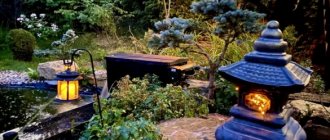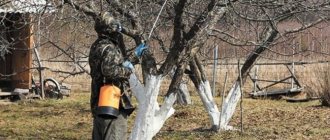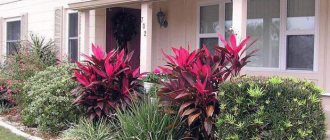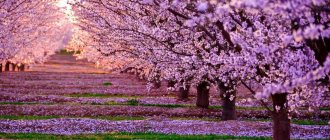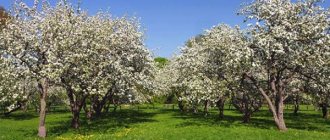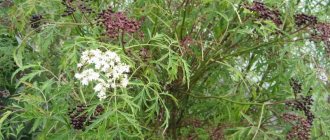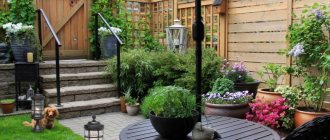Dwarf trees for the garden are very popular among owners of small garden plots. They are distinguished by their miniature, neat shapes and original appearance, which will fit perfectly into any landscape design and become an interesting decoration of the site. Despite their miniature size, dwarf trees delight gardeners with high yields with minimal care.
Dwarf trees for the garden - advantages and disadvantages
Miniature trees have long won the love of gardeners, because they give an original and impressive look to even a small area without taking up much space.
The main advantages of dwarf trees for the garden:
- Earlier start of fruiting - if standard size trees begin to bear fruit no earlier than 4-7 years after planting, then dwarf trees bear fruit within 2 years.
- Ease of care - dwarf trees have a small, neat, rounded crown that does not require additional pruning. Unlike vigorous trees, reaching 8-10 m in height, human height is quite enough to care for miniature specimens.
- Ease of harvesting - the height of dwarf fruit trees usually does not exceed 1.5-2.5 m, so harvesting a ripe crop will not cause any difficulties.
- Good survival rate - seedlings of dwarf trees are usually characterized by rapid rooting and uniform growth, so even a novice gardener can grow them.
- Harvest – dwarf fruit trees produce an excellent harvest of large fruits, which are superior in size and taste to standard garden crops.
- Versatility of use - miniature trees can be planted singly, in groups, or used as “sealers” between ordinary tall trees. They can also be used for mixed plantings, placing several different varieties next to each other - this does not affect the quality and quantity of the future harvest.
But dwarf trees also have several disadvantages. The gardener will have to spend more money on seedlings, because landscaping the area will require a large number of them.
Miniature varieties have a weak root system that often cannot withstand strong gusts of wind. Therefore, when forming a dwarf garden, you must take care of the supports.
Abutilone
Indoors, the plant from the mallow family grows up to 1.5 meters in height. The lush stem is crowned with a lush crown. It is covered with curled maple-like leaves. Because of the shape of the leaves, abutilon is called indoor maple.
Tropical abutilon loves heat and humidity and does not tolerate lack of light. Indoor maple grows and branches quickly under good supervision. In spring, its branches are covered with bright flowers - bells of pink, purple, red or gold. Flowering continues until late autumn. More than 100 varieties of indoor maple are known. The following types are common in home floriculture:
- Great;
- Juliet;
- Organza;
- Bellevue;
- Good mixture;
- Sale;
- Tiger's Eye.
The above varieties are distinguished by beautiful flowering. Every spring the green crown is covered with lush flowers. Abutilon flower is amazingly beautiful. The calyx of a large flower is crowned with bright petals covered with delicate reddish veins (seen in the photo). During the flowering period, abutilon needs abundant watering and weekly feeding.
Popular varieties of dwarf apple trees
Dwarf apple and pear trees are the most popular and widespread fruit trees, with which you can effectively decorate a miniature garden and get a high yield of fruits every year.
An important advantage of mini-apple trees is ease and ease of care.:
- Melba is one of the most famous summer super-early varieties, producing a harvest already in mid-summer. The tree begins to bear fruit in the third year after planting the seedling. Melba is famous for its unusual, pleasant vanilla-caramel taste of the fruit.
- Candy is a high-yielding variety, the height of which does not exceed 1.8 m. The fruits ripen 2-3 years after planting; from each tree you can collect up to 30 kg of greenish-yellow apples weighing 130-200 g.
- Wonderful is a miniature tree up to 1.4-1.6 m high, with excellent frost resistance and high yield. Large fruits with yellowish skin and red “barrels” have a sweet taste with notes of honey.
- Suislepskoe is an early summer variety with high yield. The crown is dense, neat and spherical, the fruits are straw-yellow in color. Their weight usually does not exceed 120-160 g.
- Autumn striped is a mid-season variety of dwarf apple trees, producing large golden-yellow fruits weighing 180-200 g. The advantage of the variety is long-term storage of the crop.
Popular dwarf trees for the garden include the Zhigulevskoe variety. The tree, 2-2.5 m high, has a round or wide-pyramidal crown that does not need pruning. Bright red apples ripen in the last days of September and are distinguished by excellent taste and good keeping quality.
Boxwood
A beautiful evergreen plant grows up to 12 m. Garden boxwood can be grown indoors. Dense greenery, forming a dense crown, will decorate the design in an oriental style. Don't forget that boxwood is considered a long-liver. With proper care, it will delight its owners for many years.
The planted shoot grows slowly, up to 5 cm per year. Around the columnar trunk, many shoots are formed, covered with small shiny leaves.
There are more than 50 varieties of boxwood. The following varieties are suitable for home breeding:
- evergreen;
- small-leaved;
- Balearic Islands.
A handsome evergreen man needs circular pruning. Boxwood branches grow quickly. A regular haircut gives the plant a well-groomed appearance. A compact boxwood figurine will be a wonderful decoration for an apartment or office. This decorative beauty perfectly purifies the air. It should be remembered that its stems and leaves are poisonous. It is not recommended to place boxwood in the nursery. Greens are also dangerous for pets.
Famous varieties of miniature pears
When creating a dwarf garden, many gardeners pay attention to miniature pears. These are neat trees with high decorative value and good fruiting. An important advantage of dwarf pears is their excellent resistance to weather changes and common diseases of fruit crops.
Dwarf pear varieties:
- Parisiana is a French variety that is famous for its unpretentiousness in cultivation, resistance to frost and excellent honey taste with a slight sourness. Large greenish-yellow pears can be stored all winter without loss.
- Veles is an autumn variety, considered one of the best in the Moscow region and central Russia. Quickly adapts to any weather conditions, bringing a high yield of round greenish fruits weighing up to 180-220 g.
- Grand Champion is one of the most famous and high-yielding varieties of dwarf pears. The tree easily tolerates temperature changes and delights with a generous harvest of large fruits with tender and juicy pulp.
Popular types of dwarf pears include Bere Ardanpont or Ferdinant - one of the oldest French winter varieties. Large yellow fruits are removed from the tree in mid-October, after which they are stored for 4-5 months. Pears have an interesting bell shape and juicy, buttery flesh with a honey taste.
How to grow bonsai from seeds?
Seeds of trees and shrubs suitable for bonsai are divided into two types. Some crops are immediately ready for germination, but the evolutionary “program” of many species includes a period of hibernation, when the sprout waits out the cold season. At home, stratification will help imitate winter.
Tree seeds for Japanese bonsai are placed in damp sand or sphagnum moss for 3–5 months, after which the container is placed in the refrigerator. At a slightly positive temperature in a humid environment, the seed prepares for growth. When it is transferred to warmth, the sprout quickly awakens. For evergreen species and plants with seeds that have a particularly durable shell, heat or temperature contrast is used to awaken.
For germination and the first months of life of seedlings, use a light sand-peat substrate or peat tablets that have been soaked and absorbed with moisture. Until a sprout appears on the surface, the container should be kept in the dark under the film. The air temperature is selected depending on the bonsai tree being grown.
To avoid the formation of condensation and rot, the greenhouse is ventilated. When seedlings appear, a small amount of fresh air is provided inside and the seedlings are transferred to light. As necessary, seedlings are watered and fertilized with complex compounds. When the plant reaches a height of 10–12 cm, it is replanted.
At this stage, the main root is shortened by a third to slow down the vertical growth of the tree. They immediately begin to form the future trunk, for which they use copper wire.
The best varieties of dwarf plums
When forming a dwarf garden, you should pay attention to plums. Miniature trees will allow you to enjoy tasty and juicy fruits even in a tiny garden plot.
Popular types of plums:
- Blue Free is a frost-resistant dwarf variety intended for cultivation in regions with cold climates. It tolerates frosts down to -38°C and is resistant to chlorosis and root canker. The fruits are dark purple in color with black speckles and a waxy coating, with a pleasant sweet-sour taste.
- Chachakskaya is a late-ripening variety. The fruits ripen at the end of September, have an oval shape and a pleasant taste with a slight sourness.
- President - this variety easily tolerates even harsh winters. It is unpretentious to growing conditions and produces a good harvest even with minimal care. The fruits are greenish-yellow in color, with a sweet taste and subtle sour notes.
No less popular varieties of low-growing plums are Yellow self-fertile, Pamyati Timiryazev, Vengerka Pulkovskaya, Stanley and Anna Shpet. They tolerate sudden changes in weather, high or low humidity, and are resistant to disease.
Ficus
There are more than 20 species of domestic trees of the ficus genus. They vary in shape and appearance. An unpretentious plant does not require frequent watering and feeding. It cleans the air well, neutralizing benzene formaldehyde and other harmful substances. Some ficus trees are poisonous. They should not be kept in a home with children or pets.
The jujube ficus produces volatile substances that are harmful to asthmatics. It is not recommended to place it in the bedroom and children's room.
Ficuses with large, juicy greens that form a dense crown look beautiful inside. The following varieties of ficus are optimal for the interior of the house:
- Ficus Benjamin;
- chewing;
- lyre;
- ficus Binnendieck;
- abundant;
- Bengal;
- dwarf;
- bottle.
Ficus is one of the most common indoor plants. Often found in apartments and offices. To make the flower look healthy, it is enough to water it abundantly from time to time.
Miniature apricots and peaches
Low-growing apricot varieties are self-fertile. They are used for growing in small areas where it is not possible to place a large number of tall trees. Dwarf apricots and peaches bear fruit every year, are very rarely affected by diseases and can withstand weather changes.
The best apricot varieties:
- Snegirek - the height of a miniature tree does not exceed 1.3-21.5 m. The variety is intended for regions with cold climates and tolerates severe frosts well, but reacts very poorly to lack of moisture. The fruits are small, up to 20 g, cream-colored with a red “blush” and tender, sweet pulp. Despite its dwarf size, the tree produces up to 12-15 kg of harvest.
- Black mouse is an original dwarf variety that attracts attention with purple-black fruits. The miniature tree can be grown both in the garden and in a large pot or tub.
- Chalychka is a high-yielding frost-resistant variety with a height of 1.4-1.6 m. It received its name due to the unusual shape of the fruits, which externally resemble cups. Apricots ripen in the first half of August and have a creamy-golden color. The fruits are small, but extremely sweet and juicy.
Among the dwarf peaches, the most popular are Capital's Anniversary, Honey, Golden Triumph, Steinberg and Gardener's Totem. The height of low-growing peaches does not exceed 1.5 m, while the fruits remain large in size - up to 300 g. The average yield of such varieties is 12-15 kg per tree.
Low-growing trees for landscaping are an ideal option for a small garden plot. Dwarf trees have gained popularity due to their combination of high decorativeness, ease of care and generous yield. They allow you to give your garden an original and spectacular look, fit harmoniously into any landscape design and make it more colorful.
Dieffenbachia
Grows up to two meters in height. The diverse guest of the sunny tropics is demanding of care. Does not tolerate drafts and cold. Irregular watering leads to yellowing of the leaves. In order for the leaf to retain its rich green color, it must be sprayed with hot water.
Dieffenbachia can liven up a dull apartment interior. But not everyone knows that its juice is poisonous. Upon contact with human skin, irritation occurs. If the juice gets into the eyes, vision problems may occur. In a family with small children and animals, it is not worth growing Dieffenbachia.
Volumetric root system
First of all, these are woody species with a branched, fairly voluminous root system, such as
Strong fibrous roots that bind the soil well form:
- common bird cherry,
- Norway maple,
- field maple,
- ash maple,
- red maple and some others,
- most elms and beech trees.
Under certain conditions, the fibrous root system is also laid by common horse chestnut, silver birch and downy birch, and some coniferous species: common larch, Scots pine, some fir trees, although it should be noted that the nature of the root system in these species varies significantly.
A site with even a slight difference in relief can be transformed by a retaining wall decorated with perennials
To a lesser extent, plants with a taproot system, which, although going deep into the soil, are poorly branched, can solve this problem. These include:
- English oak and some other types of oak,
- black alder,
- Amur velvet,
- nuts,
- many hawthorns,
- pseudotuga Menzies,
- on soils with a light granulometric composition - apple, pear and plum trees.
Shrubs
Many shrubs have a fairly powerful and branched root system:
They are also successfully used to fix slopes:
The slope is decorated and strengthened with wild roses
To strengthen and decorate steep slopes and retaining walls, planting creeping and creeping shrubs, as well as thicket-type perennials, which help create a dense or even continuous ground cover, are widely used.
Among the shrubs that will look most natural and decorative in such an environment, you should choose forms with a crown spread out or pressed to the ground, such as creeping willow and rock willow, horizontal cotoneaster and tiny cotoneaster, Thunberg barberry 'Green Carpet' or stephanandra incisifolia.
Monstera
The evergreen monstera of the liana family was brought to us from South America. The young plant looks like a bush, covered with large leathery leaves, which over time become covered with cuts and holes. Many consider it a non-blooming monster. It is not true. Tropical beauty rarely blooms. The monstera flower is a dense white bud, in the center of which is a variegated fruit, similar to an ear of corn.
Monstera is unpretentious in care. Needs regular watering and spraying. The shade-loving plant does not tolerate direct sunlight, so it is best to place it away from southern windows. It should also be noted that monsters do not like to move from place to place - you need to immediately assign them a certain angle.
Superficial root system
Species with shallow, underdeveloped roots effectively fix only the upper soil horizons on slopes, reducing the threat of erosion, but doing little to reduce the risk of landslides. This group of trees and shrubs includes:
Shallow roots are also noted:
- at the Japanese scarlet,
- silver maple,
- maple Ginnala,
- cypress trees,
- thuja occidentalis,
- hemlock,
- at the goat willow,
- brittle willow,
- white willow and many others, but this “disadvantage” is more than compensated by their high growth activity.
Organizing a trail system on slopes can replace terracing
Camellia
A typical representative of the tea family, camellia stubborna, will decorate the interior of an apartment with its lush, lush blooms. Under suitable conditions it blooms profusely. Over time, an enlarged crown forms. The Japanese beauty is capricious in its care. The room temperature should be maintained no higher than 15 degrees. For growth and flowering, air humidity and constant watering with fresh water are required. The reward will be abundant flowering. In spring, camellia is covered with large inflorescences consisting of white, pink and purple petals.
A coffee tree
Coffee grows in the warm tropical climate of Africa. The coffee plant loves warmth and humidity. In order for it to grow well, it needs to be placed in a warm, lighted place. The room must maintain a stable temperature of at least 18 degrees. In winter, you cannot place the seedling on the windowsill - the lump of earth in the pot may cool down and the sprout will die.
If the seedling is well cared for, regularly watered and sprayed, then under favorable conditions it will grow up to 1.5 meters. The stem thickens to form a trunk, which is crowned by an enlarged crown covered with wavy vegetation. It blooms twice a year: in spring and autumn. Small white flowers that emit a delicate aroma turn into green coffee beans.



